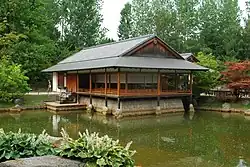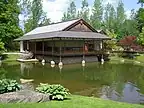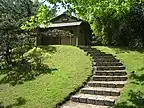Japanese Garden of Hasselt
The Japanese Garden of Hasselt is a park in the Belgian city of Hasselt. Designed in the traditional 17th-century style, it was donated to the Belgian city by the city of Itami. It is the largest Japanese garden in Europe.[1][2]
| Japanese Garden | |
|---|---|
 Kōrokan in Hasselt's Japanese Garden | |
| Type | Japanese garden |
| Location | Gouverneur Verwilghensingel 15, Hasselt, Belgium |
| Coordinates | 50°56′07″N 5°21′21″E |
| Area | 2.5 hectares (6.2 acres) |
| Status | Open year round |
History
The garden was designed by the Japanese architect Takayuki Inoue.[1][3] The garden was built by a group of skilled Japanese gardeners in the early 1990s, and inaugurated on 20 November 1992, after 250 working days.[2][1]
The location for the garden was chosen by architect Inoue.[1] The city of Itami provided all financial and material contributions.[1] The planting of the chosen area was preserved as closer to the original as possible, showing the respect for nature of the Japanese.[1]
The skilled Japanese gardeners landscaped the chosen site with a small hill, flowing brook, waterfall, pebbly beach, bridges, tea house and a number of other traditional Japanese buildings.[2][1] Stones were brought from Austria to build the bridges, whereas the buildings were built exclusively with materials brought in from Japan.[1] Many trees and bushes were planted.[1] Measuring 2.5 hectares, Hasselt's Japanese garden is the largest Japanese garden in Europe.[4][5][6]
The best time to visit it is considered to be spring, when 250 cherry trees flower.[4][2]
Gallery
 Bridge with tea house in the background
Bridge with tea house in the background Waterfall
Waterfall Waterfall 2
Waterfall 2 The Tea House
The Tea House Hill with traditional Japanese building
Hill with traditional Japanese building Yatsuhashi bridges
Yatsuhashi bridges Sawatari-ishi, stepping stones over water
Sawatari-ishi, stepping stones over water Flowering cherry blossom (sakura)
Flowering cherry blossom (sakura)
References
- "The Japanese Garden Today". www.visithasselt.be.
- "Hidden Belgium: The largest Japanese garden in Europe". The Brussels Times.
- "Chasing Cherry Blossom in Japanse Tuin Hasselt (Japanese Garden of Hasselt)". www.theflashpacker.net.
- Jacobs, Peter; Wouter, Rawoens (2003). Best of Belgium la Belgique comme vous devez la voir. Lannoo. p. 54. ISBN 9789020952087.
- De Moor, Paul; Antoine, Jean-Marie; Blyth, Derek (2006). 365 dagen België. Lannoo. ISBN 9789020967821.
- Belgium and Luxembourg. Fodor's Travel Publications. 2001. p. 174. ISBN 9780679007708.